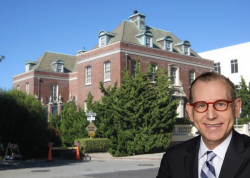 Tech layoffs could bring an early close to 2022 SF residential market
Tech layoffs could bring an early close to 2022 SF residential market
Trending
SF luxury buyers wait on sidelines as inventory climbs
Agents note lots of “circling” but few offers as economic headwinds slow sales

With only weeks to go until the San Francisco luxury market shuts down for the holiday season, agents say that uncertainties on everything from the job market to the stock market are causing inventory levels to rise and making it difficult for buyers to pull the trigger on offers.
“There is drastically more inventory for high-end buyers to choose from, so we are seeing a lot of buyers ‘circling’ for weeks, but nobody stepping up to write the offer,” said Compass agent Missy Wyant Smit via email. “We have seen this occasionally in the past, but not to this extent.”
The slowing sales trend is not limited to luxury, as last month had the lowest volume of any October in over a decade in San Francisco and the lowest volume since 2007 in the 11-county greater Bay Area, according to Compass data. But Bay Area luxury home sales—those priced over $5 million—were hit even harder than the rest of the market, with a 43% drop year over year, compared with 37% for the general market. Ultra luxury homes, those priced over $10 million, now have over 11 months of inventory throughout the Bay Area, according to Compass. In San Francisco, there are 17 months of inventory at this price point.
The overall housing market in the city started feeling the impact of interest rate increases in March, but it took until the stock market began faltering in May for the luxury market to take a hit as well, according to Compass. As the financial markets continued their bumpy ride into the fall, high-end buyers reacted to the rollercoaster by pulling back from the market.
Luxury buyers are feeling “less rich than they were” in the spring, said Compass agent David Bellings. Their losses may not impact whether or not they can actually afford a $10 million-plus property, he said, but it’s human nature to feel the need to conserve when faced with an onslaught of negative economic news.
“Everyone feels better about spending money when the market is up,” he said.
Sotheby’s agent Deborah Svoboda recently listed a $35 million property on San Francisco’s Gold Coast and said that “buyers are definitely feeling what’s going on in the stock market,” but that “there are those people who really want to be on those three blocks of Broadway and they’re willing to pay for it.”
The city saw a rash of $30 million and up sales this summer, including a $35 million off-market Gold Coast sale that may wind up as the biggest residential deal in the city this year.
What’s the value?
Given the erratic summer and quiet fall, it can be difficult for agents today to price upper-end homes appropriately. For a view home on “Billionaire’s Row” in particular, the regular rules may not apply, said Patrick Barber, Compass regional president.
“Who knows what the value is [on those three blocks]?,” he said. “There’s only so many houses on the north side of the street.”
High-end agents also have to weigh what their client wants to list the home for, which is often more than the market will bear. Even if a listing agent can explain the comps to the client, if the seller says their home must be worth millions more, many agents will give it a shot with the expectation that they can drop the price later, Barber said.
“They’re shopping to find where the market is,” he said of this year’s seven- and even eight-figure price cuts. “It didn’t lose $10 million in value. It never had that value.”
Agents often say that in a changing market, sellers look six months into the past and buyers look six months into the future, according to Smit.
“We try to find the balance for today,” said Smit, who recently dropped the asking price on one of her Presidio Heights $10 million-plus listings by $850,000. “When we do need to do a price reduction, we advise our clients to reduce by 5 to 10 percent, depending on how aggressive the original list price was. So, while a $1 million reduction feels drastic, it is often within that range for high-end listings.”
Smit said that agents don’t just look at the homes that have sold to find their comps in a slow market, but the homes that don’t sell as well.
“They tell us what price point is too high and that we should price our listings more realistically,” she said. “But the ground is shifting, and sellers understandably do not want to be the test cases for finding the new normal. So it’s taking a little more time to find the new sweet spot for pricing.”
Bellings expects the market to pick back up in the spring, in part because it may take that long for high-end sellers to come to terms with how their homes need to be priced and see enough other sales, or lack thereof, to believe that their home is no longer worth what it once was. It’s a bitter pill to swallow if the home listed just a bit too late to take advantage of the red-hot market earlier this year.
“I’ve had clients who were a few weeks off and that’s hard,” he said. “But you can’t kick yourself for too long.”
He hopes those newly resolved sellers will be met by New Year’s Resolution buyers, who he said may have a psychological reset come mid-January when the first few post-holiday sales start coming in.
“It really is a herd mentality,” he said. “Right now they’re all on the edge of the pool, waiting for someone to jump in.”
Read more
 Tech layoffs could bring an early close to 2022 SF residential market
Tech layoffs could bring an early close to 2022 SF residential market
 Billionaire Glazer family linked to SF's priciest home sale of 2022
Billionaire Glazer family linked to SF's priciest home sale of 2022
 SF’s most expensive listing cuts price $10M
SF’s most expensive listing cuts price $10M




